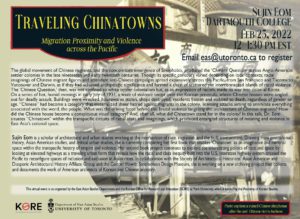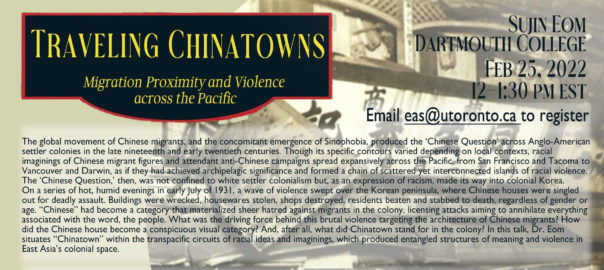Traveling Chinatowns: Migration, Proximity, and Violence across the Pacific
February 25, 2022

EVENT DESCRIPTION
The global movement of Chinese migrants, and the concomitant emergence of Sinophobia, produced the ‘Chinese Question’ across Anglo-American settler colonies in the late nineteenth and early twentieth centuries. Though its specific contours varied depending on local contexts, racial imaginings of Chinese migrant figures and attendant anti-Chinese campaigns spread expansively across the Pacific, from San Francisco and Tacoma to Vancouver and Darwin, as if they had achieved archipelagic significance and formed a chain of scattered yet interconnected islands of racial violence. The ‘Chinese Question,’ then, was not confined to white settler colonialism but, as an expression of racism, made its way into colonial Korea.
On a series of hot, humid evenings in early July of 1931, a wave of violence swept over the Korean peninsula, where Chinese houses were singled out for deadly assault. Buildings were wrecked, housewares stolen, shops destroyed, residents beaten and stabbed to death, regardless of gender or age. “Chinese” had become a category that materialized sheer hatred against migrants in the colony, licensing attacks aiming to annihilate everything associated with the word, the people. What was the driving force behind this brutal violence targeting the architecture of Chinese migrants? How did the Chinese house become a conspicuous visual category? And, after all, what did Chinatown stand for in the colony? In this talk, Dr. Eom situates “Chinatown” within the transpacific circuits of racial ideas and imaginings, which produced entangled structures of meaning and violence in East Asia’s colonial space.
SPEAKER
Sujin Eom is a scholar of architectural and urban studies working at the intersection of race, migration, and the built environment. Drawing from postcolonial theory, Asian American studies, and critical urban studies, she is currently completing her first book that situates ‘Chinatown’ as an imaginative and material space within the transpacific history of empire and violence. Her second book project continues to explore the intersecting politics of race and space by looking at elevated highways as a traveling urban form that reveals how the racial and class inequity built into the U.S. interstate highway system crossed the Pacific to reconfigure spaces of inclusion and exclusion in Asian cities. In collaboration with the Society of Architectural Historians’ Asian American and Diasporic Architectural History Affiliate Group and the Cooper Hewitt Smithsonian Design Museum, she is working on a new archiving project that collects and documents the work of American architects of Korean and Chinese ancestry.
---
This virtual event is co-organized by the East Asian Studies Department at University of Toronto and the Korean Office for Research and Education (KORE) at York University, which is funded by the Academy of Korean Studies.





